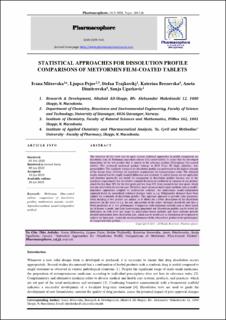| dc.contributor.author | Mitrevska, Ivana | |
| dc.contributor.author | Pejov, Ljupco | |
| dc.contributor.author | Trajkovikj, Stefan | |
| dc.contributor.author | Brezovska, Katerina | |
| dc.contributor.author | Dimitrovska, Aneta | |
| dc.contributor.author | Ugarkovic, Sonja | |
| dc.date.accessioned | 2022-12-16T10:15:37Z | |
| dc.date.available | 2022-12-16T10:15:37Z | |
| dc.date.created | 2020-11-09T12:30:31Z | |
| dc.date.issued | 2020 | |
| dc.identifier.citation | Pharmacophore. 2020, 11 (3), 104-116. | en_US |
| dc.identifier.issn | 2229-5402 | |
| dc.identifier.uri | https://hdl.handle.net/11250/3038225 | |
| dc.description.abstract | The objective of this work was to apply several statistical approaches to profile comparison on dissolution data of Metformin immediate release film-coated tablets to assure that the developed formulation of the test product that is similar to the reference product (Glucophage film-coated tablets). The evaluated medicinal product belongs to BCS Class III (high solubility, low permeability). The similarity testing of the dissolution profile was performed on the highest strength of the dosage form, following the regulatory requirements for bioequivalence study. The obtained results showed that the simple standard difference and similarity (f1 and f2)-factors are not applicable and therefore practically not useful for comparison of dissolution profiles because one of the regulatory requirements that the relative standard deviation or coefficient of variation of any product should be less than 20% for the first point and less than 10% from second to last time point, which was not achieved in the present case. Therefore, more advanced multivariate methods such as model-dependent approaches coupled to multivariate statistics, the multivariate model-independent approach based on generalized statistical distance (such as e.g. Mahalanobis distance) have been applied for evaluation of dissolution profiles. This approach appeared to provide extra arguments when deciding if two profiles are similar, as it allows for a better description of the dissolution processes (in the sense of e.g. the rate and amount of the active substance dissolved) and thus a better prediction of in vivo performance. Comparison with traditional methods such as those based on fit-factors is made, and their shortcomings pinpointed out. Dissolution profiles can be tested for differences in both level and shape by multivariate-based methods and these methods provide detailed information about dissolution data, which can be useful also in formulation development to achieve the final goal – match the actual performance of the released test product to the performance of a target reference product. | en_US |
| dc.language.iso | eng | en_US |
| dc.publisher | Jadoun Science Publishing Group | en_US |
| dc.relation.uri | https://pharmacophorejournal.com/QtHt2GI | |
| dc.rights | Navngivelse 4.0 Internasjonal | * |
| dc.rights.uri | http://creativecommons.org/licenses/by/4.0/deed.no | * |
| dc.title | Statistical Approaches for Dissolution Profile Comparisons of Metformin Film-Coated Tablets | en_US |
| dc.type | Peer reviewed | en_US |
| dc.type | Journal article | |
| dc.description.version | publishedVersion | en_US |
| dc.rights.holder | the authors | en_US |
| dc.subject.nsi | VDP::Matematikk og Naturvitenskap: 400::Kjemi: 440 | en_US |
| dc.source.pagenumber | 104-116 | en_US |
| dc.source.volume | 11 | en_US |
| dc.source.journal | Pharmacophore | en_US |
| dc.source.issue | 3 | en_US |
| dc.identifier.cristin | 1846121 | |
| cristin.ispublished | true | |
| cristin.fulltext | original | |

